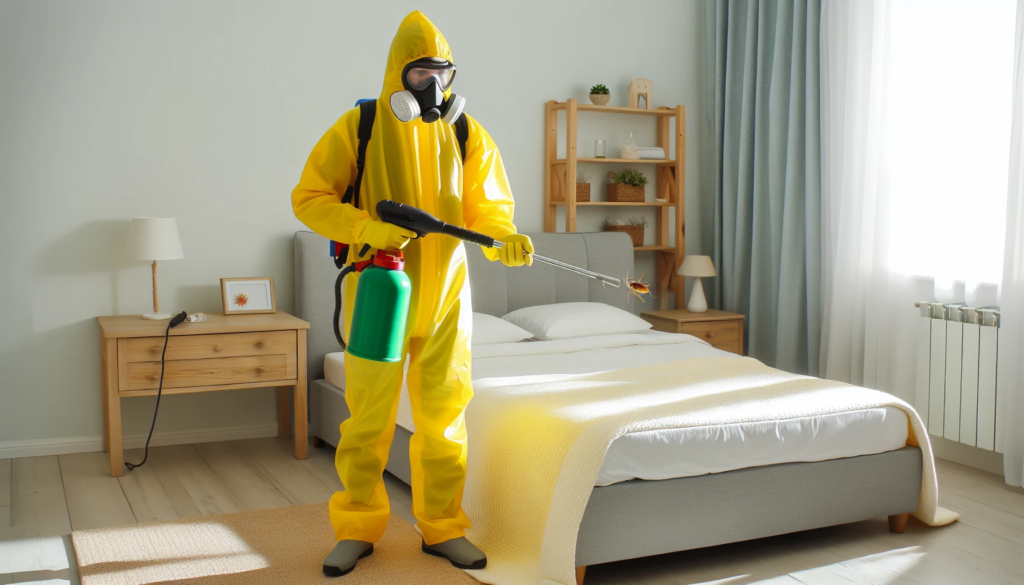Top-Rated Bed Bug Exterminator: DC Exterminator for Effective Treatment
Top-Rated Bed Bug Exterminator: DC Exterminator for Effective Treatment
Blog Article
Checking Out the Scientific Research Behind Bed Insect Heat Treatments as a Lasting Pest Monitoring Approach
In the realm of parasite administration, the quest for reliable and sustainable solutions stays a constant search. One such technique that has gained grip in recent times is making use of warm therapies to fight bed pest invasions. By harnessing the scientific research behind thermal death factors for these relentless insects, warmth treatments use an appealing choice to conventional chemical-based strategies. The complexities of just how warm effectively eliminates bed insects and the more comprehensive effects for sustainable bug monitoring practices make this a topic worth checking out better.
Bed Bug Heat Treatment Process

Thermal Fatality Point for Bed Bugs
Exposing bed pests to raised temperature levels past their thermal resistance range is critical for achieving efficient removal in warmth treatment procedures. The thermal death factor for bed bugs refers to the temperature level at which these insects can not endure. Research suggests that bed bugs start to perish when subjected to temperatures above 113 ° F(45 ° C) for a continual period. As the temperature raises, so does the mortality rate of bed pests. At around 118 ° F(48 ° C ), bed bugs start to pass away rapidly, with a mortality price of nearly 99% within minutes of direct exposure. This shows the sensitivity of bed insects to high temperature levels and highlights the efficiency of warm therapies in removing problems. By reaching and preserving temperature levels over the thermal death point for bed insects, parasite management experts can make certain extensive elimination of bed pest populaces, including hard-to-reach locations where chemical therapies may be less efficient. Recognizing the thermal death factor for bed pests is important for applying successful warm therapy methods and achieving sustainable pest monitoring outcomes.
Benefits of Warm Treatments
Having actually established the essential thermal death factor for bed bugs, it is critical to now discover the significant advantages that warmth therapies provide in properly eliminating these durable parasites. One of the main benefits is that heat can permeate deep right into gaps and splits where bed bugs hide, making sure that also the most hard-to-reach areas are heated up to deadly temperature levels.
Furthermore, warm therapies are ecologically pleasant and safe, making them a lasting pest administration approach. Unlike chemical pesticides, heat treatments do not leave dangerous deposits that can pose risks to human health and wellness or the environment. This aspect is particularly crucial in delicate settings such as medical facilities, institutions, and suburbs where chemical usage may not be desirable.
Furthermore, heat treatments have a high success price in getting rid of bed pest infestations in a solitary treatment, reducing the need for multiple check outs and lessening disturbance to occupants. This performance not just saves money and time yet additionally provides peace of mind to those taking care of bed insect troubles.
Effectiveness of Warm Treatment

Warmth therapies have the added benefit of killing bed insect eggs, which are usually immune to traditional chemical treatments. Generally, the performance of warmth therapies in eradicating bed bug infestations makes them a lasting and trustworthy parasite management strategy.
Sustainable Pest Management Advantages
Implementing sustainable parasite monitoring techniques supplies long-lasting benefits for both the environment and public wellness. By making use of techniques such as heat treatments for parasite my link control, we can minimize the reliance on hazardous chemical pesticides that can have adverse results on ecological communities and human health and wellness - bed bug heat treatment. Sustainable pest monitoring methods help in maintaining biodiversity by targeting certain pests without damaging non-target organisms, thereby keeping a balanced ecosystem
In addition, sustainable parasite administration practices add to the overall wellness and wellness of the general public. By lessening exposure to poisonous chemicals utilized in traditional bug control methods, warm therapies supply a much safer alternative for parasite administration in domestic, business, and public spaces. This decrease in chemical usage likewise helps in preventing chemical residues from infecting soil, water, and air, protecting environmental high quality.
Verdict
Finally, bed pest heat therapies have actually been shown to be a sustainable and efficient insect management approach. The thermal fatality point for bed bugs makes them vulnerable to warmth treatments, which have various benefits over typical chemical treatments. The effectiveness of warm treatments in getting rid of bed pest problems while minimizing ecological influence highlights the possibility of this approach as a sustainable solution for insect control.
The bed insect warm treatment process includes increasing the temperature level within ravaged locations to a degree that properly removes bed pests and their eggs. By getting to and keeping temperature levels over the thermal best site fatality factor for bed insects, bug monitoring experts can make sure detailed removal of bed insect populations, including hard-to-reach areas where chemical treatments might be much less reliable. One of the key benefits is that warm can permeate deep into fractures and gaps where bed bugs hide, guaranteeing that even the most hard-to-reach areas are heated to lethal temperature levels. Unlike chemical page therapies that might leave behind immune populations, heat treatments provide a non-toxic and environmentally friendly service that can permeate deep into furniture, wall surfaces, and various other hard-to-reach areas where bed bugs hide.
The thermal death point for bed pests makes them susceptible to heat treatments, which have various advantages over traditional chemical treatments.
Report this page